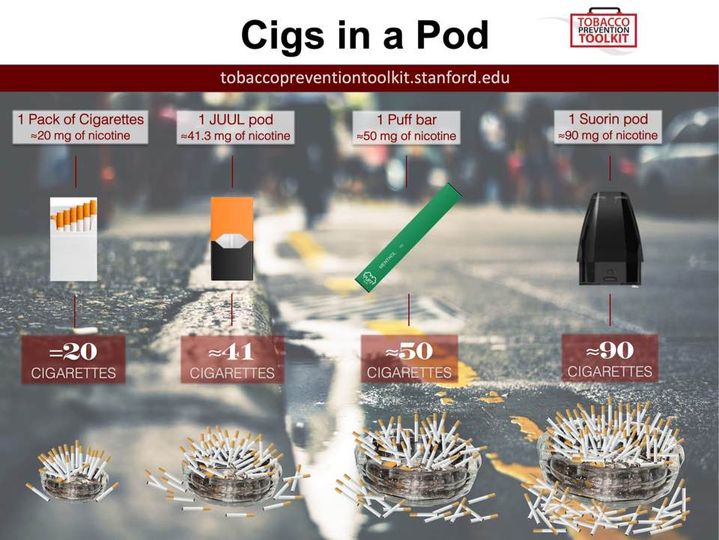Note: Posters and infographics provide at the end of the page.
- Not all vaping is the same: differential pulmonary effects of vaping cannabidiol versus nicotine, 2023, February
- Vaping Dose, Device Type, and E-Liquid Flavor are Determinants of DNA Damage in Electronic Cigarette Users, 2023, February 14
Vaping Induced Cannabidiol (CBD) Oxidation Product CBD Quinone Forms Protein Adducts with KEAP1 and Activates KEAP1-Nrf2 Genes, 2023, March 31 -These results suggest that vaping CBD alters protein function and induces cellular stress pathways in the lung.
Conclusions Vaping of CBD induces a potent inflammatory response and leads to more pathological changes associated with lung injury than vaping of nicotine.
https://thorax.bmj.com/content/early/2023/02/22/thorax-2022-218743Vaping Cannabinoid Acetates Leads to Ketene Formation
Vaping Dose, Device Type, and E-Liquid Flavor are Determinants of DNA Damage in Electronic Cigarette Users– Vape users had 2.6x more DNA damage than non-smokers. 2023, Feb 14
Delta-8 THC acetate is a relatively new psychoactive cannabis product that is available online and in vape shops across the US since it is currently unregulated. Because it contains a similar substructure to vitamin E acetate, which has been shown to form the poison gas ketene during vaping, we investigated potential ketene formation from delta-8 THC acetate, as well as other cannabinoids acetates, CBN acetate and CBD acetate, under vaping conditions. Ketene was consistently observed in vaped condensates from all three acetates as well as from a commercial delta-8 THC acetate product purchased online.
https://chemrxiv.org/engage/chemrxiv/article-details/627401c36cae1c94a5fe8fe7
Weed vapes probably sending a toxic gas to your lungs, study finds
JULY 20, 2022
The study adds to a number of eyebrow-raising findings about the potential health consequences of vaping products
Now, a new study by Portland State University’s Robert Strongin, doctoral student Kaelas Munger, and Robert Jensen reveals that when cannabinoid acetates in marijuana vaping products are heated under vaping conditions, they create a toxic gas called ketene.
https://www.salon.com/2022/07/20/weed-vapes-probably-sending-a-gas-to-your-lungs-study-finds/
Major Uptick Reported in Cannabis Vaping for All Adolescents
May 19, 2022
LARGEST INCREASES FOUND AMONG HIGH-SCHOOL SENIORS, TRIPLING IN 2 YEARS FROM 5 TO 14 PERCENT
Cannabis vaping is increasing as the most popular method of cannabis delivery among all adolescents in the U.S., as is the frequency of cannabis vaping, according to research at Columbia University Mailman School of Public Health. The study found that the frequency of vaping cannabis among adolescents from all demographic groups is reported at six or more times per month, and rising faster than occasional use. Those who vape and smoke nicotine are more than 40 times more likely to also vape and smoke cannabis.
Use of Electronic Cigarettes Among Cannabis-Naive Adolescents and Its Association With Future Cannabis Use
July 22, 2022
Adolescents who used e-cigarettes were significantly more likely to become new smokers of cannabis shortly thereafter, a cohort study found.
Cannabis-naive adolescents reporting ever vaping at baseline were more than twice as likely to report also using cannabis when surveyed a year later (adjusted RR 2.57 vs nonusers of e-cigarettes, 95% CI 2.04-3.09), reported Ruoyan Sun, PhD, a health behavior researcher at University of Alabama at Birmingham, and colleagues. https://www.medpagetoday.com/primarycare/smoking/99871?xid=nl_mpt_DHE_2022-07-22&eun=g1235130d0r&utm_source=Sailthru&utm_medium=email&utm_campaign=Daily%20Headlines%20Evening%202022-07-22&utm_term=NL_Daily_DHE_dual-gmail-definition
Question Is electronic cigarette use among cannabis-naive adolescents in the US associated with increased likelihood of future cannabis use?
Findings With the use of longitudinal data on a nationally representative cohort of 9828 youths from 2017 to 2019, this cohort study found that cannabis-naive adolescents who have used electronic cigarettes are significantly more likely to report cannabis use 1 year later compared with those who have not used electronic cigarettes.
Meaning The findings of this cohort study suggest that adolescent electronic cigarette use was associated with an increased likelihood of future cannabis use, but the overall association of electronic cigarette use with youth cannabis use at the population level is likely quite small.
Longitudinal associations between e-cigarette use and onset of multiple modes of cannabis use among US adolescents
Youth e-cigarette use was associated with onset of multiple modes of cannabis use.
https://www.sciencedirect.com/science/article/abs/pii/S030646032200082X?via%3Dihub
American Thoracic Society– Lung injuries from e-cigarettes or vaping can lead to long-term issues including respiratory problems, cognitive impairment and mental health issues, according to an Intermountain Healthcare study.
Find the study here: https://www.ksl.com/article/50418868/long-term-respiratory-cognitive-and-mental-health-issues-tied-to-vaping-study-says https://www.atsjournals.org/doi/abs/10.1513/AnnalsATS.202201-049OC
Frequency of adolescent cannabis smoking and vaping in the United States: Trends, disparities and concurrent substance use, 2017–19
cannabis use with vaping is accelerating; frequent cannabis vaping is especially increasing, with consistent increases across almost all adolescent demographic groups.
Certain groups, such as Hispanic/Latino or lower socio-economic status adolescents, experienced particularly notable increases in frequent cannabis use with vaping (e.g. prevalence among Hispanic/Latino adolescents)
https://onlinelibrary.wiley.com/doi/abs/10.1111/add.15912
Adolescent E-cigarette or Vaping Use-Associated Lung Injury in the Delaware Valley: A Review of Hospital-Based Presentation, Management, and Outcomes
Vaping is a serious issue that can cause acute devastating lung injury to our youth. Our experience with adolescent EVALI highlighted the variety of presentations and course of illness among patients. Eliciting a vaping history, negative infectious testing, elevated inflammatory markers, and characteristic CT findings were key to making the diagnosis of EVALI. Research is still limited on adolescent EVALI and the long-term sequala; however, outcomes in our population were reassuring with abstinence and steroids
Cureus. 2022 Feb; 14(2): e21988.Published online 2022 Feb 7. doi: 10.7759/cureus.21988
Prevalence of Adolescent Cannabis VapingA Systematic Review and Meta-analysis of US and Canadian Studies
JAMA Pediatr. Published online October 25, 2021. doi:10.1001/jamapediatrics.2021.4102
Question What is the prevalence of adolescent cannabis vaping in the US and Canada?
Findings This systematic review and meta-analysis reviewed 17 unique studies from the US and Canada, with a total of 198 845 adolescents, and found that the lifetime prevalence of cannabis vaping doubled from 2013 to 2020 (6.1% to 13.6%), past 12-month use doubled from 2017 to 2020 (7.2% to 13.2%), and the 30-day prevalence of cannabis vaping increased 7-fold from 2013 to 2020 (1.6% to 8.4%). Preference for cannabis products may be shifting from dried herb to cannabis oil
Meaning The findings of this study suggest that more effective prevention and response measures are required to mitigate the increasing prevalence of cannabis vaping among adolescents.
Cannabis, Vaping, and Respiratory Symptoms in a Probability Sample of U.S. Youth
Published:March 03, 2021DOI:https://doi.org/10.1016/j.jadohealth.2021.01.019
Results: The odds of indicating “wheezing or whistling” in the chest were roughly two times higher among those who had used cannabis in ENDS (adjusted odds ratio 1.81, 95% confidence interval 1.47–2.22); neither e-cigarettes nor cigarettes had a significant association with all five respiratory symptoms in the fully adjusted models
Conclusions: This study provides preliminary evidence that adolescents’ cannabis use with ENDS may have negative health consequences. Lifetime cannabis use with ENDS was substantially associated with higher odds of respiratory symptoms.
https://www.jahonline.org/article/S1054-139X(21)00047-1/fulltext
Update: Product, Substance-Use, and Demographic Characteristics of Hospitalized Patients in a Nationwide Outbreak of E-cigarette, or Vaping, Product Use–Associated Lung Injury — United States, August 2019–January 2020
On January 14, 2020, this report was posted online as an MMWR Early Release.
Although most EVALI cases have been associated with use of informally sourced THC-containing products, 16% of patients reporting use of THC-containing products reported acquiring them only from commercial sources. Even in states where marijuana has been legalized for recreational use by adults,¶ it might be difficult to determine whether a source is licensed through the state. For example, in California, the Bureau of Cannabis Control seized nearly 10,000 illegal vape pens from unlicensed retailers during December 10–12, 2019.** The high prevalence of informally sourced THC-containing products among EVALI patients reinforces current recommendations to not use THC-containing e-cigarette, or vaping, products, particularly those acquired from informal sources.
https://www.cdc.gov/mmwr/volumes/69/wr/mm6902e2.htm?s_cid=mm6902e2_w

